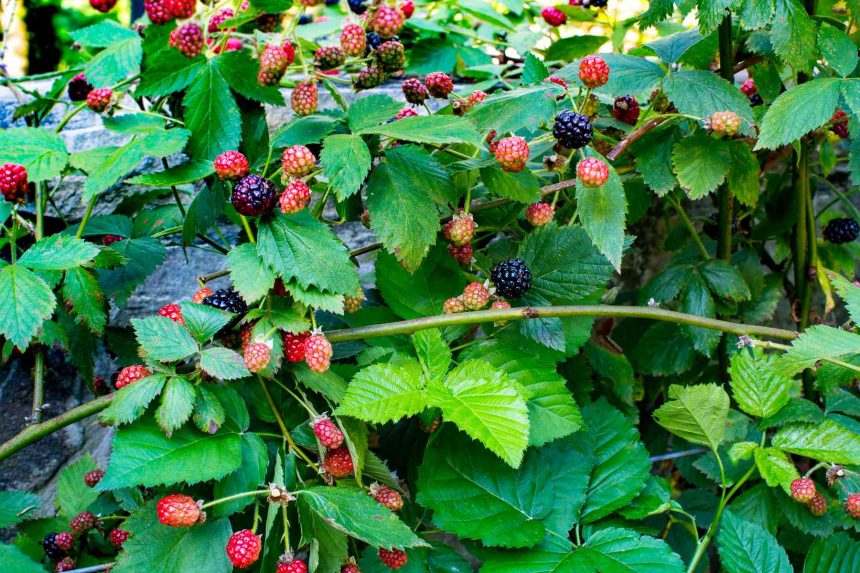| Common Name: | DownHome Harvest® ‘Navaho’ Thornless Blackberry |
| Botanical Name: | Rubus hybrid ‘Navaho’ |
| Family: | Rosaceae |
| Plant Type: | Perennial, shrub |
| Mature Size: | 4-5′ high x 3-4′ wide |
| Sun Exposure: | Full sun |
| Soil Type: | Fertile, medium moisture, well-drained |
| Soil pH: | Slightly acidic (5.5-6.5) |
| Bloom Time: | Spring |
| Flower Color: | White |
| Hardiness Zones: | 6 to 10 |
| Native Area: | North America, South America, Europe, Asia |
| Toxicity: | Non-toxic to people and pets |
‘Navaho’ Thornless Blackberry Care
With an erect growth habit, DownHome Harvest® ‘Navaho’ Thornless Blackberry plants do not require trellising. This makes the plants much more versatile in the landscape as compared to trailing varieties. Erect blackberries like ‘Navaho’ can be planed in traditional rows or grown as a hedge. Their vase-like form lends an attractive element to ornamental plantings. Give plants a sunny location in fertile, well-draining soil.
Light
‘Navaho’ blackberry plants produce best with full sun but tolerate some shade, though fruiting may be reduced. For best performance, provide at least six hours of direct sun per day.
Soil
Blackberries tolerate a range of soils, including clay, so long as it drains well. Plants thrive in fertile, slightly acidic loam or sand loam. Amend soil with compost or aged manure to provide organic matter.
Water
For optimal fruit production, supplement rainfall as needed to provide one to two inches of water per week during the fruiting season. Drought and water stress decrease production and berry quality, while overwatering can lead to root rot. For new plantings, irrigate one to two times per week until plants are established.
Temperature and Humidity
‘Navaho’ blackberry plants are winter hardy to zone 6 and tolerate the heat and humidity of Southern gardens. In hot climates, harvest fruit in the morning and refrigerate as soon as possible. Blackberries and other fruit crops require a chilling or rest period before plants will produce flowers. This rest period is measured in chill hours, and different blackberry varieties have different chilling requirements. ‘Navaho’ blackberry requires 800 chilling hours for optimal fruit production and is best suited to cooler areas within its range.
Fertilizer
Wait until the year after planting to start fertilizing blackberries. Apply fertilizer when blackberry plants flower to stimulate plant growth, increase berry size, and boost fruit production. Make a second application following fruit harvest to stimulate cane growth. For each application, apply a nitrogen fertilizer such as ammonium sulfate or bloodmeal in a foot-wide circle around each plant according to label rates.
Types of Blackberry
‘Navaho’ Thornless Blackberry was developed by University of Arkansas horticulturists as part of their premier small fruit research and development program. In recent years, the program has developed a variety of improved blackberry varieties featuring thornless canes and improved disease resistance. These introductions are self-pollinating, so you only need to plant one variety to produce fruit.
Blackberries are commonly categorized into three groups according to their growth habit: erect, semi-erect, and trailing plants. Erect blackberries like DownHome Harvest® ‘Navaho’ Thornless Blackberry are popular among home gardeners because they do not require trellising. Other traits to consider when selecting blackberry varieties for the garden include fruiting season and chilling requirements. ‘Navaho’ is a late season producer, with fruits maturing late June to July.
How To Plant ‘Navaho’ Thornless Blackberry
Blackberries are available either as dormant plants, typically bare root, or as actively growing potted plants. Dormant and bare root blackberries are set in the ground during winter, between January and March, depending on your location. Actively growing plants can be planted after the threat of frost has passed.
Amend soil prior to planting with compost or aged manure. Space plants three to four feet apart, ensuring blackberries planted in ornamental beds have at least a three-foot circumference free of competition for rooting. Mulch plants to conserve soil moisture and discourage weeds.
-
Water potted plants well before transplanting to prevent roots from drying out during the planting process. Soak bare root plants for two hours before planting to rehydrate the roots.
-
Dig a planting hole 2-3 times as wide as the root ball. This allows you to spread out the root system.
-
Gently remove the plant from its pot and loosen the roots.
-
Set plants only deep enough such that their root collars (where branches meet the root system) are level with or slightly above the surrounding soil level. If planting bare root plants, build a small mound at the center of the planting hole to raise the crown of the plant while allowing roots to spread outward and downward.
-
Fill the planting hole with the original soil removed from the hole, pressing the soil down gently with your hand.
-
Water plants thoroughly and apply 1 to 2 inches of mulch, avoiding the area closest to stem.
Pruning ‘Navaho’ Thornless Blackberry
Pruning is a critical part of blackberry production. Blackberry plants naturally produce stems called canes that live for only two years before dying and being replaced by new stems. The first-year canes arise from the base or crown of the plant and are called primocanes. These canes grow all season and then go dormant over the winter. During the winter, the primocanes become floricanes or flowering canes. These second-year floricanes will flower and set fruit during the growing season as the plant produces new primocanes from the crown.
During their first growing season after planting, allow ‘Navaho’ Thornless Blackberry plants to produce as much growth as possible without pruning. These early canes may sprawl over the ground instead of growing upright. Do not worry about training these, as plants will produce erect canes in subsequent years.
Blackberries are pruned at three separate times during the season, as outlined below. Begin pruning blackberries the year after planting. When you first begin pruning, you will pick up at the second step below–summer pruning.
Winter Pruning: Trim lateral branches.
During the dormant season, overwintering primocanes become floricanes. These canes grew last season and have several lateral shoots branching off the main cane where fruit will be produced during the summer. In late winter, trim these lateral branches to a length of 12 inches to encourage larger, higher quality berries. Make cuts just above a bud.
Summer Pruning: Tip primocanes.
New primocanes emerge from the base of plants in spring and grow vigorously during the summer. Around mid-summer, these first-year primocanes need to be pruned to encourage better fruit production next season. Simply cut the tip of each cane back to a height of 3 to 4 feet above ground level. This is called “tipping.” Tipping forces the cane to develop lateral shoots, which is where next season’s fruit will grow.
Fall Pruning: Remove old floricanes and thin primocanes.
By fall, this season’s floricanes have completed fruiting and are ready to be removed. They may be dying back or appear woody. Cut off these old stems to ground level or just above the crown if it is visible. After removing floricanes, thin out the number of floricanes, leaving about 5 of the strongest canes and cutting the rest to ground level. Thinning increases air circulation within the canopy, which fights plant diseases. It also reduces the fruit load, which results in larger, higher quality berries.
For proper pruning, it is important to differentiate between primocanes (first year canes) and floricanes (second year canes). Primocanes typically exhibit a waxy bloom, while floricanes look woody. They will also have old fruit clusters still clinging to the tips of branches. Always remove and dispose of pruned material. Blackberries can suffer from a number of diseases and removing spent canes from the garden is an important part of pest management.
How To Get ‘Navaho’ Thornless Blackberry To Bloom
Blackberries are among the easiest fruits to grow and seldom withhold blooms. If plants fail to flower, assess irrigation practices. An inadequate water supply during flowering can decrease production. Likewise, plants stressed due to over watering may decrease flowering. Inadequate chilling can also impact flowering. Plants that do not receive the required number of chill hours may experience reduced or erratic blooming and fruit production. Consult your local extension agent or a map of chilling hours to ensure the variety you are growing matches local chilling hours.
Overwintering
Blackberries are hardy plants that require little extra care overwinter. Mulch plants in late fall after a hard freeze to protect the crowns and make sure plants enter the dormant season with adequate soil moisture. Irrigate plantings once a month during the dormant season if the soil dries.
Propagating ‘Navaho’ Thornless Blackberry
DownHome Harvest® ‘Navaho’ Thornless Blackberry is patent-protected and cannot be propagated.
Common Pests & Plant Diseases
Blackberries are susceptible to a number of diseases. DownHome Harvest® ‘Navaho’ Thornless Blackberry is resistant to anthracnose, a common disease pest, but is susceptible to orange rust and double blossom disease. To reduce the incidence of disease, practice good sanitation and remove any wild brambles that may be growing on your property. When pruning, make cuts just above a bud rather than below. When canes are cut below a bud, the remaining short section of cane is prone to infection. Always collect and dispose of pruned stems.
Double blossom, also called rosette disease, can be controlled with heavy pruning of diseased stems in early spring. As always, dispose of cut material. Follow pruning with repeated fungicide applications from bud break until flower petals fall. Plants with orange rust, identified by orange pustules on the leaves, must be burned or disposed of in the trash.
Common Problems
Birds love blackberries as much as people do. If birds are a problem, cover blackberry plants with bird netting to protect fruits. Nets can be removed after harvest is complete.





